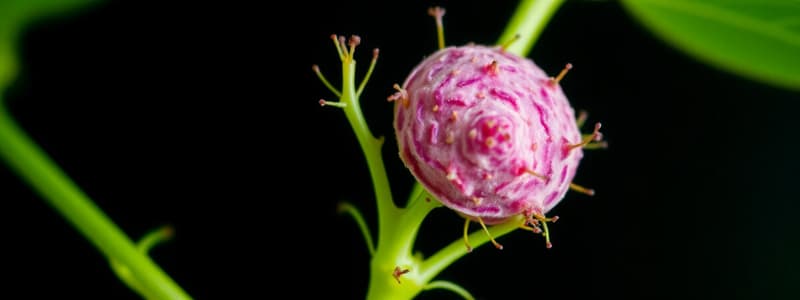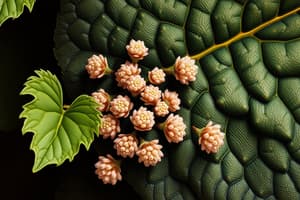Podcast
Questions and Answers
What role does procambium play in plant development?
What role does procambium play in plant development?
- It becomes the supporting tissues of the plant.
- It develops into primary vascular tissues. (correct)
- It is involved in photosynthesis.
- It develops into roots and leaves.
What is a primary function of intercalary meristem in monocots?
What is a primary function of intercalary meristem in monocots?
- To support the plant structure during drought.
- To allow for rapid recovery after grazing. (correct)
- To enhance the plant's reproductive capabilities.
- To enable horizontal growth of the plant.
Where is intercalary meristem located in monocots?
Where is intercalary meristem located in monocots?
- At the base of nodes and leaf blades. (correct)
- At the tips of roots and shoots.
- Along the outer bark of the plant.
- Within the vascular bundles.
How does intercalary growth benefit monocots in relation to herbivores?
How does intercalary growth benefit monocots in relation to herbivores?
What type of tissue does procambium primarily differentiate into?
What type of tissue does procambium primarily differentiate into?
Flashcards
Procambium function
Procambium function
Develops into primary vascular tissues (xylem and phloem).
Intercalary meristem location
Intercalary meristem location
At the base of nodes and leaf blades in monocots.
Intercalary meristem's role
Intercalary meristem's role
Promotes plant growth in length; helps plants regenerate quickly.
Intercalary meristem's adaptation
Intercalary meristem's adaptation
Signup and view all the flashcards
Procambium's location
Procambium's location
Signup and view all the flashcards
Study Notes
Plant Tissues
- Plant tissues are categorized as meristematic or permanent.
- Meristematic tissues are based on their "capacity to divide."
- Permanent tissues are based on their "origin."
- Meristematic tissues are further classified as primary or secondary based on their "origin."
- Primary meristems include apical and intercalary meristems classified by "position."
- Secondary meristems include lateral meristems classified by "position."
- Apical meristems are located at the tips of stems and roots, promoting growth in length.
- Intercalary meristems are located at the base of nodes and leaf blades (primarily in monocots), promoting growth in length between nodes.
- Lateral meristems are located on the sides of stems and roots; responsible for secondary growth, increasing stem and root diameter.
- Procambium: a part of apical meristem that develops into primary vascular tissues (xylem and phloem).
- Monocots (like grasses) have intercalary meristems allowing leaves to regrow after mowing.
- Dicots have lateral meristems responsible for secondary growth, increasing stem and root diameter.
Meristematic Tissues
- Primary meristems are apical and intercalary.
- Secondary meristems are lateral.
- Types and placement are significant in determining growth patterns.
Apical Meristems
- Located at the tips of stems and roots.
- Responsible for primary growth, increasing stem and root length.
Intercalary Meristems
- Located between the tip and base of stems and leaves.
- Promotes growth in length, specifically between nodes.
- Essential for plants like grasses to recover from herbivory.
Lateral Meristems
- Located on the sides of stems and roots.
- Responsible for secondary growth, increasing stem and root diameter.
- Vascular cambium and cork cambium are examples.
Growth Types
- Primary growth: Increases the length of stems and roots.
- Secondary growth: Increases the diameter of stems and roots.
Summary Comparison (Apical vs. Intercalary vs. Lateral)
| Feature | Apical Meristem | Intercalary Meristem | Lateral Meristem |
|---|---|---|---|
| Location | Tips of stems and roots | Between nodes and leaf blades | Sides of stems and roots |
| Function | Increase stem and root length | Increase length between nodes | Increase stem and root diameter |
Studying That Suits You
Use AI to generate personalized quizzes and flashcards to suit your learning preferences.




